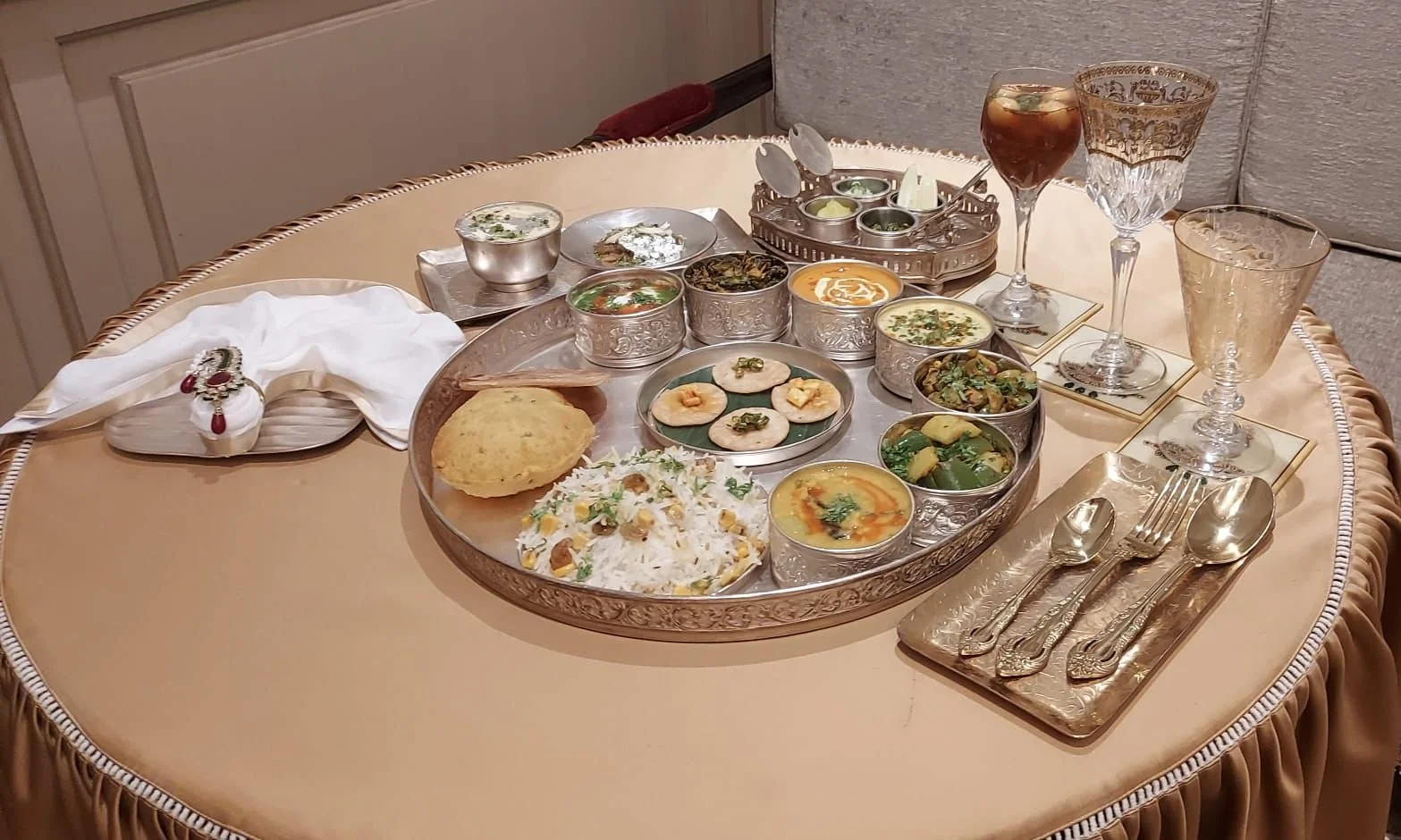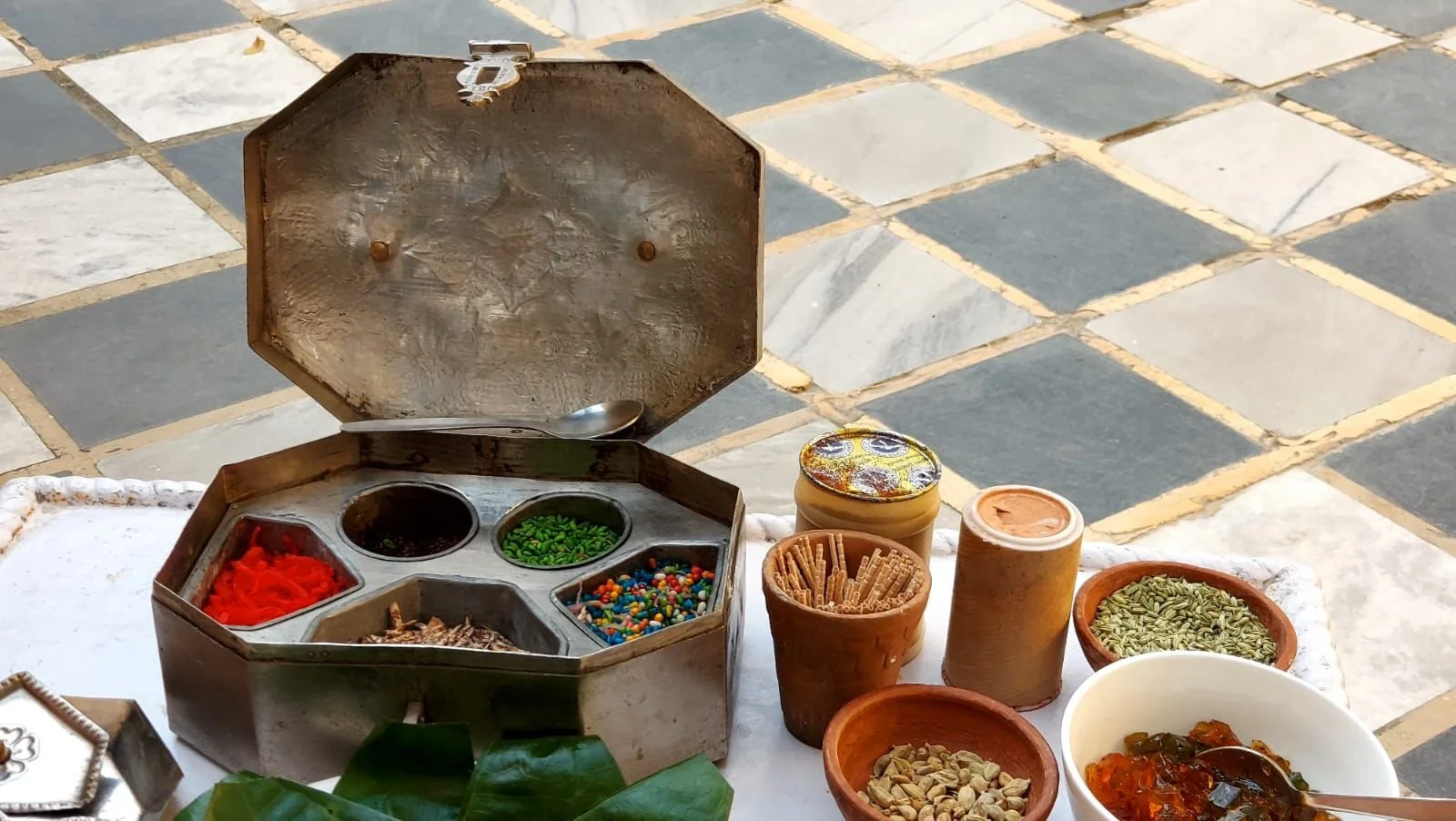No Onion, No Garlic, Still Royal: The Opulent Simplicity of Sheherwali Cuisine
Dinner is served in a formidable silver thali. Several small silver bowls hold a spread of carefully prepared dishes, boraphali ka tarkari, dahi ka hola, and kela parwal ka jholgiri to name a few. When the puri arrives, eating only the top layer, the thin flaky part, is perfectly acceptable. In fact, you might even be perceived as an insider if you do so. For dessert, you might not even need to wait till the end. Saloni mewa ki khichdi, bode ki boondiya, or if the fasting season has just concluded, the thali could feature mirich.
This is a typical Sheherwali meal, the result of a distinct food culture created and upheld by the Jains of Murshidabad, Bengal.
A three hundred year old legacy
In the mid-18th century, Bengal was undergoing a period of immense political and economic changes. The Mughal Empire had weakened, and Bengal was turning into a semi-independent state under the rule of the Nawabs who were now actively looking for bankers, traders, and financiers to support their expanding administration and economy. Jain merchants from Rajasthan travelled the country to lend their economic expertise and money and in search of opportunity and stability made their way east, eventually settling in Murshidabad, then a thriving capital and commercial hub. They established themselves in the suburbs, Azimganj, Jiaganj, Lalbagh, Nashipur, and Cossimbazar, and overtime came to be known as the Sheherwalis. The term Sheherwali was used by those living in the outskirts or smaller towns surrounding Murshidabad, signaling a kind of urban sophistication and exclusivity that came to define the Sheherwali identity both in lifestyle and in cuisine.
In his book Sheherwali: The Regal Vegetarian Cuisine of Murshidabad, Pradip Chopra writes, “It is a confirmed view that the combined wealth of the twenty to thirty-odd Sheherwali families settled within a one-kilometre diameter of the twin cities of Azimganj and Jiaganj surpassed that of the British aristocracy at that time.” This extraordinary concentration of wealth, paired with their migrant histories and exposure to multiple cultural influences, created what he calls “a wonderful mélange of the cuisines of the west and the east of India.”
From scarcity to abundance
These migrants, albeit richer than most, came from a land marked by scarcity. Life in the arid villages of Rajasthan had shaped their culinary instincts, inventive, and by virtue of their religion, strictly vegetarian. The food does not even use onions and garlic, or produce that requires a plant to be taken by the root. Once in Murshidabad, their food traditions began to evolve because apart from money, they now had access to fresh vegetables, fruit, grains, and Bengal’s fertile land and water.
Their Rajasthani sensibilities, in clothing, mannerisms, ingredients, and cooking techniques, gradually absorbed everything Bengal had to offer at that time. The result was Sheherwali cuisine where Rajasthan, with its ghee-laden gravies and spice-heavy cooking, met the royal kitchens of Afghanistan and the Mughal empire, the syrupy indulgence of the Bengali sweet tooth, and the aesthetic refinement of Nawabi dining, all on a strictly vegetarian table.
In Rajasthan, lentils and beans often replaced fresh vegetables, and gram flour, bajra, and corn were staples. These remained in the Sheherwali repertoire, but the ingredients were changed, made decadent. Take dal baati churma for instance. The dal is made with five different pulses, baati was made and fried in oil, some crumbled and mixed with sugar to make churma. In Sheherwali kitchens, this humble crumble was garnished with saffron, dry fruits, and the Sheherwali cryptonite, rose water. While root vegetables remained off-limits, flavour came from amchoor (dried mango), hing (asafoetida), and an unshy use of chillies.
The Sheherwali pickle of crushed red chillies in lime juice, kutti mirch ka achar, is known for its punch. Raw jackfruit (kathal ka tarkari), banana flower (mocha ka tarkari), wood apple chutney (kathbel chutney), puffed rice laddoos (muri ka laddoo), and borey ki boondiya (a sweet made with white bean powder) are all dishes born in Bengal, reimagined within Sheherwali kitchens. Even the Bengali panch phoran, a mix of mustard, cumin, fennel, nigella, and fenugreek, found a place in their tempering, merging the Sheherwali and Bengali kitchens.
The Nawabi nazakat
As Kolkata emerged as a new capital under British rule, it also became a place of exile for many noble families. Among them were the Nawab of Awadh and the descendants of Tipu Sultan from Mysore. These exiled royals brought with them their own cooks, masalchis (spice grinders), recipes, and traditions. Their kitchens were rich with cloves, cinnamon, cardamom, saffron, and mace. This influx of Islamic culinary influences left a lasting mark. The use of kewra jal, ittar, and rose essence, hallmarks of Awadhi and Mughlai refinement, were enthusiastically adopted.
Closer to home, Azimganj’s sprawling orchards added their own fragrant stamp. Varieties like anaras, bimli, champa, and rani mangoes were eaten and celebrated by the Sheherwali families. Mangoes were pickled, juiced, turned into chutneys and desserts, sometimes into khacche aam ka kher. Sometimes they were simply compared. Competition between families about whose orchard had the more flavourful variety, whose fruit carried more fragrance. Food, especially seasonal food, was as much about pride and performance as it was about nourishment.
This love for excess, for finery, for food that was both art and ritual, extended especially to sweets. If the Bengali has a sweet tooth, the Sheherwali table responds with dessert before, during, and after the meal. Morning breakfast could be a spread of sweets, milk and a variety of confections. In winter, there is khaaja, a jaggery and sesame delicacy, and neemas, a frothy milk preparation lightened from its Mughlai original and perfumed with saffron and rose water. Bode ki boondiya, made from white bean flour, is special to Murshidabad and rarely found elsewhere. Many curries balance sweet with sour, or sweet with heat, often adding jaggery to achieve that perfect note.
Women as custodians of culture
What makes Sheherwali food especially hard to replicate, and even harder to commercialise, is the level of care, time, and attention it demands. Ingredients and techniques were both expensive and exacting. Vegetables must be cut uniformly, peas must be graded: the smallest for salads, medium for curries, and larger ones for stuffing kachoris. “Our people are very finicky about their foods and tastes, hence the smallest component matters,” shares Sandip Nowlakha, a hotelier and the descendant of one of the Jain families who originally migrated to Murshidabad.
Cooking was trial, error, and patient experimentation, much of it led by the women of the house, working closely with chefs, many of whom came from different regions. It was in this space of collaboration and curiosity, underlined by enormous wealth, that new dishes were born. Nowlakha recounts how a cookbook he worked on, documenting recipes passed down through the women in his family, found its way to the corporate chef of ITC Delhi.
“He came to Kolkata to meet us. After years of featuring the food at festivals, ITC finally included it in their regular menu,” he shares. “ITC Royal Vega now offers a proper Sheherwali thali, and we host a dinner where 30 of our chefs cook alongside 100 ITC staff to serve a curated seven-course Sheherwali meal for around 50 dignitaries here in Kolkata.”
What is changing?
Each household developed its own signature, a perfected recipe, a particular preparation, and took pride in being known for it. “In our house we still make Sheherwali food regularly. As for the ingredients, the availability is there but the quality is surely deteriorating. Even in Kolkata, we get our rose water from Murshidabad because the quality is simply unmatched. You open a vail and it lights up the entire room. Given that the fragrance in these dishes has to be a particular kind and it only comes from the rose water from Murshidabad, even ITC gets its rose water from there,” Nowlakha shares.
There’s also a particular nazakat to the Sheherwali table, in its flavours, its service, its discipline, and even its final flourish: paan as the last course, ceremonially served. It combines the manuwar of Rajasthan, the hospitality of Bengal, and the grandeur of Islamic courts, all folded into a strictly Jain framework. The food is guided by faith, yes, but it is shaped by imagination, rigour, and pride. Taste, in every sense of the word, is serious business to a Sheherwali.


